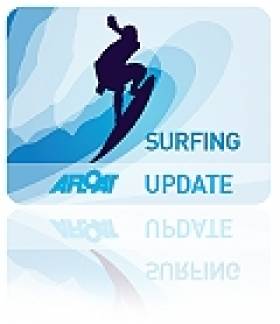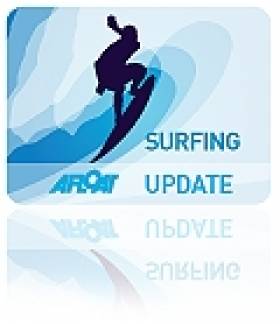Displaying items by tag: windsurfing
Windsurfers Race to Kerry for Red Bull Storm Chase
#Windsurfing - Due to 2012's calm storm season, organisers of the Red Bull Storm Chase recently extended the competition into this year - and competitors are currently racing to Ireland for the first mission of the contest.
Brandon Bay in Kerry was decided as the spot early this morning, and the competition is scheduled to begin just after sunrise tomorrow (Monday 28 January) when stormy weather conditions are expected to be at their peak.
The Red Bull Storm Chase website has live updates from competitors making their way to Kerry from as far away as the Marshall Islands in the Pacific Ocean.
Ten windsurfers chosen by community vote will take part in the first mission, with the top six going on to the second mission some time before 22 March at any one of seven possible destinations around the world, most of which have not before taken centre stage on the windsurfing scene.
Sadly no Irish windsurfers will be competing this time round, but names the likes of Timo Mullen and Dan Gardner on the shortlist will surely be keeping an eye on the competition as they get set to chase the ride of their lives.
Father Pays Tribute to Windsurfing 'Warrior' Mikey Clancy
#Windsurfing - Michael Clancy, father of late windsurfing prospect Mikey Clancy, has issued a statement following the tragic death of his son last week.
On behalf of the Clancy family, he wrote:
Mikey Clancy, a rising star in the PWA, has passed away. His story is well known to many with an incredible comeback following a serious injury. Mikey loved the sea as a child and although he only stepped on board a windsurfer at 15 years of age he made rapid progress in the sport over the following years.
Windsurfing was his passion and he loved the friendships he made whether it was Victor [Fernandez] , Timo [Mullen], Klaas [Voget], Kauli [Seadi] or the many Irish and UK friends he made, he always had time and fun with them. He was a consummate pro with his sponsors Fanatic, North, Ion, DIT, K4Fins and had often ridden in storm-chase conditions in Ireland.
His family Michael, Bernie and Sean wish to thank the thousands who celebrated Mikey’s life in Dublin this week and all those who were sent their condolences from around the globe. We will miss Mikey and remember him fondly for his sportsmanship, kindness and friendly manner. Your smile and humour lit up many a windsurfers day. May you dance on the seas of heaven as you once danced on the seas of the ocean.
Bye Mikey ... we will all see you soon.
Michael Clancy has also made an appeal for anyone experiencing depression to seek help.
Speaking to the Irish Daily Mirror, he said of his son Mikey: “We are very happy that we had a fantastic 22 years of life with him and sadly some people’s lives are shorter than others.
“A book can be a short story or it can be a grand novel. What he had packed into his life was amazing.”
Talking of his son's tragic decision to end his own life, Michael said: “It’s a horrendous cultural thing that Ireland is developing, it really is. It seems to be getting worse rather than better.”
However, he added: “Whilst we are extremely heartbroken and shocked at the news we want to celebrate that he had a good innings in a lot of aspects.”
As reported previously on Afloat.ie, Mikey Clancy had come back last year from a serious ankle injury to produce the best results of his burgeoning pro career, with a year-best 13th place at the Cold Hawaii Classic in October.
“He was really a warrior," said his father Michael. “He got to the very top of world windsurfing twice, once before the injury and once after the injury.”
According to the Mirror, Mikey's ashes will be spread over various beaches in Ireland during the year.
Irish Windsurf Pro Mikey Clancy Passes Away
#Windsurfing - News has come in of the untimely death of Irish professional windsurfer Mikey Clancy.
The Dubliner, who was just 22 years of age, competed on the PWA World Windsurfing Tour and had just returned to the world windsurfing stage in 2012 after being sidelined for most of 2011 by a serious ankle injury.
According to website Surfdock, Clancy was nominated by Outsider Magazine for their People of the Year Awards recognising his strong comeback, including a year-best 13th place at the Cold Hawaii Classic in Denmark last October - and this 25-foot monster wave he ripped off the Donegal coast last March.
As recently as a week ago the young windsurfing talent shared his thoughts with windsurfing website Continent Seven on the year past and his hopes for 2013 on the waves.
Check out the video above of Mikey Clancy doing his thing in July 2010 and below a tribute video posted on YouTube on Tuesday 8 January. He will be missed.
Mikey Clancy's family has since passed along details of his funeral this week for the Irish windsurfing community.
Mikey will be waked at 51 Ashcroft in Raheny, Dublin 5 tomorrow 9 and Thursday 10 January. All are welcome at the family home.
The funeral mass will take place at 11am on Friday 11th at St Brigid's Church on the Howth Road in Killester, Dublin 5. Following a private family cremation, everyone is invited to celebrate Mikey's life at Clontarf Castle.
Sailrocket 'Smashes' World Speed Sailing Record
#SPEED RECORD - Weymouth-based sailor Paul Larsen and his crew have laid claim to a new world record in speed sailing, as BBC News reports.
The team say they achieved an average speed of over 59 knots - with a peak of 63.5 knots - on a half-kilometer run at Namibia's Skeleton Coast using their purposely designed Vestas Sailrocket 2.
Their speed "smashed" the previous record of 55.65 knots set by kitesurfer Rob Douglas in the 2010 Luderitz Speed Challenge, although it is yet to be confirmed by the World Speed Sailing Records Council.
It was the culmination of 10 years' hard work on the part of Australian-born Larsen and his team, using the specially adapted design built on the Isle of Wight - a vessel that's "very impractical in conventional sailing terms", as Larsen told the Times.
He added: "We are buzzing — no-one has done this with a sailing boat before... This shows how unique and revolutionary the boat is.
"We’ve had to break the boundaries of sailing — like the equivalent of our sound barrier — just over 50 knots."
The boat's designer Chris Hornzee-Jones said the vessel - inspired by the success of speed sailing kitesurfers and windsurfers like Oisín can Gelderen - was key to their breakthrough.
"It is designed to be an ideal testing platform for trialling new foil concepts which will allow us to break through this 'glass ceiling' and perform at speeds well over 60 knots.”
RYA Statement on Reintroduction of RS:X Windsurfing for 2016 Olympic Games
#rya – The Royal Yachting Association (RYA) has welcomed the decision by delegates at the International Sailing Federation's (ISAF) General Assembly to re-introduce RS:X windsurfing for the 2016 Olympic Games in place of kiteboard racing.
ISAF Council voted to replace the men's and women's windsurfing disciplines with men's and women's kiteboard racing at its mid-year meetings in May of this year, and again reaffirmed this position at its meeting yesterday, but the wider ISAF membership reversed the decision at the General Assembly today, voting in favour of RS:X windsurfing for the Rio Games.
RYA Racing Manager and Performance Director John Derbyshire said: 'This is what the membership of the RYA asked for – we have a very strong youth pathway and some 10,000 windsurfing members of the RYA, so on their behalf we are delighted with the decision.
'We obviously have great compassion towards the kiteboarding community, with whom we have been working very closely, and I am sure that they will continue to work very closely with both the RYA and ISAF families with a view to gaining inclusion for the discipline in future Olympic Games.
'We can now look forward to preparing for Rio 2016 with the clarity that this decision brings.'
The events for the Rio 2016 Olympic Sailing competition are now confirmed as:
Men's Board - RS:X
Women's Board - RS:X
Men's One Person Dinghy – Laser*
Women's One Person Dinghy - Laser Radial*
Men's second One Person Dinghy - Finn
Men's Skiff - 49er*
Women's Skiff – 49erFX*
Men's Two Person Dinghy - 470
Women's Two Person Dinghy - 470
Mixed Two Person Multihull – Nacra 17
*The Laser, Laser Radial, 49er and 49erFX have also been approved as Core Events and Equipment for the 2020 Olympic Sailing Competition.
Derbyshire also offered the RYA's congratulations to the new ISAF President Carlo Croce (ITA), who was voted to serve an initial four year term. Great Britain's Chris Atkins was voted as one of seven new ISAF Vice Presidents and will also serve an initial four year term as part of the organisation's Executive Board.
Bitter Blow for Kites as Windsurfing is Reinstated in Olympics
#OLYMPICS - Windsurfing has been reinstated in the Olympic Games programme at the expense of new class kitesurfing after a vote by the International Sailing Federation (ISAF) yesterday, as Eurosport reports.
It had been expected that sailing's world governing body would reach a compromise of sorts at its annual general meeting in Dun Laoghaire by keeping both classes in the Rio Games in 2016.
The original decision to replace windsurfing with the new sport of kitesurfing back in May was considered a surprise move, but the ISAF has surprised again with its reversal of that decision.
Windsurfing's supporters were said to be "shell-shocked" by the original vote, and vowed to lobby the ISAF to overturn the decision in Dublin, for which they needed a two-thirds majority.
Israel's sailing head Yehuda Maayan told Reuters that delegates had likely been confused about the original vote because of language difficulties, noting that the Spanish delegate had voted for kiteboarding by mistake.
Among those expressing their disappointment at the about face was Virgin founder Richard Branson, who wrote on his blog that the ISAF had "have misled everybody and been very short-sighted in making this knee-jerk decision".
He added: "Their original decision was the right one and a brave one, although my own feeling is that there is room for both sports in the Olympics. If they had to drop anything it should have been one of the less exciting sailing races, which really don't capture the public's imagination."
The move is also a bitter blow for Irish kitesurfer Claudine Murphy, sister of Olympic star Annalise Murphy, who had been campaigning in the new class to make it a sister act at the Rio Games.
In other news from yesterday's ISAF AGM, new members of the ISAF Council have been announced.
Italy's Carlo Croce was elected president and chair of the council that also includes seven vice presidents: George Andreadis (Greece), Chris Atkins (UK), Adrienne Greenwood (New Zealand), Nazli Imre (Turkey), Gary Jobson (USA), Quanhai Li (China) and W Scott Perry (Uruguay).
Also on the council are a non-voting treasurer (yet to be confirmed), 28 representatives from member national authorities (MNAs) and individual representatives from the athletes' commission, the ISAF classes, offshore sailing and women's sailing. Sailing.org has full details on the new council HERE.
from ISAF
Kiteboards Out / Windsurfing Back In
Dun Laoghaire, Ireland: After three days of meetings, the ISAF Annual Conference drew to a close Saturday as the final decisions affecting the sport moving forward were made.
23 submissions relating to the events and equipment for Rio 2016 were received by ISAF in advance of the Conference. In accordance with the ISAF Regulations, before the detail of any of these particular submissions could be discussed, Council were required to vote on a motion to re-open the debate on the subject. The Regulations specify that 75% of members must agree to the motion.
The submissions were presented as six proposals and Council asked to vote on them in terms of the specific changes they proposed. The first proposal grouped. 26 Council members voted in favour and 12 were against.
Proposal 2, which featured Submission 063-12, related to Men's Kiteboarding, Women's Kiteboarding and 2nd One Person Dinghy - Finn. 14 Council members voted in favour and 23 were against and 1 abstained.
With 38 possible votes, the 75% requirement was not achieved on either proposal so the events and equipment as approved in May 2012 remain for Rio 2016.
However, at the ISAF General Assembly part of the business for the 106 Member National Authorities (MNAs) who were present was to review any regulations made or amended in any substantive way by Council since the last Ordinary Meeting which was in November 2011.
ISAF had been notified of three amendments proposed by MNAs which concerned the first two lines of Regulation 23.1.4 (Men's and Women's Kiteboarding).
As defined in the Articles of ISAF, decisions at the General Assembly shall be taken by a simple majority of votes of those present and entitled to vote. There were 114 possible voters, including the ISAF President and Vice-Presidents.
After a lengthy debate the MNAs approved the first proposal which reinstated Men's and Women's Boards - RS:X.
ISAF Regulation 23.1.4 now reads:
Men's Board - RS:X
Women's Board - RS:X
Men's One Person Dinghy - Laser
Women's One Person Dinghy - Laser Radial
Men's 2nd One Person Dinghy - Finn
Men's Skiff - 49er
Women's Skiff - 49erFX
Men's Two Person Dinghy - 470
Women's Two Person Dinghy - 470
Mixed Two Person Multihull - Nacra 17
sailing.org
Irish Windsurfer 13th in PWA Cold Hawaii World Championships
#windsurfing – Irish windsurfer Mikey Clancy IR253 has finished in 13th position in the KIA PWA Cold Hawaii World Championships in Klitmoller Denmark. In brutal onshore conditions Mikey achieved his highest ranking in a PWA Competition and the highest ever ranking by an Irish windsurfer in the wave discipline.
Clancy who has been a professional windsurfer for the last four years has recovered from a serious ankle injury competed in two rounds of the Professional Windsurfing Association World Tour over the last three weeks in Klitmoller Denmark and the grand final event in Sylt Germany last week.
The D.I.T. Marketing student trains mainly at Dollymount beach in Dublin and on the West Coast of Ireland. Clancy hopes to break into the worlds top 10 over the coming seasons and seeks a major sponsor to help him achieve this goal.
Galway's Top Junior Windsurfers Battle it Out for Academy Honours
#windsurfing – Galway's top junior windsurfers battled it out over 10 races and a freestyle session for the 2012 Rusheen Bay Windsurfing Junior Academy Awards titles on Saturday.
The winners were Diarmuid Mc Cormack and Fiona Reidy.
The academy began in April and ran every Saturday and Sunday morning. Participants were coached by some of the country's top windsurfers and all showed excellent progress towards the end of the season.
Notable performances also on the day came from Oisin Concannon who won several races. Inline with the competition results, the 2012 Rusheen Bay Junior Mens and Ladies Windsurfer of the year prizes were awarded to Diarmuid McCormack and Fiona Reidy.
The 2013 Junior Windsurfing Academy will recommence again in April.

Scott Kennedy (Manager, RBW), Fiona Reidy (RBW 2012 Ladies Windsurfer of the Year), Diarmuid McCormack (RBW 2012 Mens Windsurfer of the Year), Danny Mulryan (RBW)
#KITESURFING - The International Sailing Federation (ISAF) has responded to the legal challenge from the International RS:X Class Association to its decision to cut Olympic windsurfing from the Rio games in 2016 in favour of kitesurfing.
As previously reported on Afloat.ie, kitesurfing was given two medal events at the next Olympics following a mid-term meeting of the ISAF Council in Italy nearly three months ago.
In a statement, the ISAF said it "intends to fully defend the decision of the ISAF Council, which was made in accordance with the ISAF regulations and the defined decision making processes of the ISAF."
Sailing's world governing body said it was "extremely disappointed that this course of action has been taken" - rather than the "normal submission process" to request the council to reconsider its decision at the ISAF AGM in November - "not least because responding to legal claims will incur substantial and unnecessary legal costs for ISAF and for the class itself."
There has been some controversy surrounding the decision to include kitesurfing over windsurfing at the Rio games after claims that the council vote was married by "language difficulties" among the Spanish delegate.
Spain, a long-time windsurfing stalwart, surprised many by joining the 19-17 vote in favour of the newer discipline, which was supported by Ireland's John Crebbin.
#WINDSURFING - Ireland's top windsurfers had a big day in Castlegregory recently at the second event in the Irish Slalom Series.
With a steady 20-25 knots of wind complemented by flat water, conditions were perfect on Saturday 2 June for the nearly 40 competitors across the Gold and Silver Fleets, as IrishSlalom.ie reports.
Veteran boarder Maurice Owens took first place in the Gold Fleet, holding off Irish wave sailing champion Rob Jones from doing the double.
But the champ was still able to provide a lesson in technique, staying on a 6.2 metre sail and 84 litre slalom board all day.
Third place went to Fintan Day, who squeaked past William 'Wookie' Revels after a hard-fought battle on the waves.
Meanwhile, in the Silver Fleet competition was immense, with very little separating the great from the good.
Paul Green picked up overall first place, while Steven Lawless consistently finished in the top three.
The next date on the calendar is set for the weekend of 21 July at Downings in Co Donegal.
IrishSlalom.ie has more on the story HERE.






































































